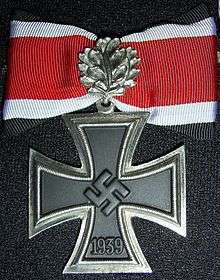Joachim Schepke
| Joachim Schepke | |
|---|---|
 | |
| Nickname(s) | Ihrer Majestät bestaussehender Offizier ("Her Majesty's best-looking officer") |
| Born |
8 March 1912 Flensburg |
| Died |
17 March 1941 (aged 29) south-east of Iceland 61°N 12°W / 61°N 12°W |
| Allegiance |
|
| Service/branch |
|
| Years of service | 1930–41 |
| Rank | Kapitänleutnant |
| Unit |
SSS Niobe cruiser Emden Meteor Cruiser Deutschland |
| Commands held |
U-3 U-19 U-100 |
| Battles/wars | World War II |
| Awards | Knight's Cross of the Iron Cross with Oak Leaves |
Joachim Schepke (8 March 1912 – 17 March 1941) was a German U-boat commander during World War II. He was the seventh recipient of the Knight's Cross of the Iron Cross with Oak Leaves of Nazi Germany.
Career
Schepke was the son of a naval officer, and he joined the Reichsmarine in 1930. In 1934 he was assigned to the newly created U-boat arm, and in 1938 he commanded U-3. At the outbreak of World War II he took U3 to war against Allied shipping. After a short stint commanding U-19 and serving in a staff position Schepke received the command of U-100, a Type VIIb boat. After 5 patrols in U-100 she was heavily damaged on 17 March 1941 by depth charges from HMS Walker and Vanoc while executing an attack on Convoy HX-112. U-100 was forced to surface and was detected on radar and consequently rammed by Vanoc. Schepke and 37 crew members perished in the ocean; six crew members were rescued. Schepke was last reported on the bridge of U-100. When Vanoc rammed his boat, he was crushed against his own periscope standards, and he went down with his boat.[1]
Schepke claimed to have sunk 37 ships, for a total of 213,310 gross register tons (GRT), and damaged 4 more. If true, this would have made him the third skipper to have sunk over 200,000 tons. While he did positively sink 34 ships, he was known to Admiral Dönitz and throughout the fleet to exaggerate his tonnage claims; fellow U-boat men used the expression "Schepke tonnage" in reference to them. Nonetheless, with 34 ships Schepke ranked first in number of ships sunk, and was recommended by Dönitz for Knight's cross with Oak Leaves for this achievement.[2]
Schepke, Günther Prien and Otto Kretschmer were friendly rivals in the U-boat service, and were the most famous U-boat commanders in the early years of the war, where all except Kretschmer eventually met their ends. Schepke was the favourite of these three, because in contrast to Kretschmer he was a convinced Nazi. He wrote and illustrated the book "U-Boot Fahrer von Heute" (U-Boat Men of today) in 1940 (Berlin, Deutscher Verlag 1940). In February 1941 he made a speech in the Berlin Sportpalast for thousands of Berlin schoolchildren about the U-boat war. Before and after his death the German propaganda ministry held him as an example for German youth to follow.[3]
Summary of career
Awards
- Iron Cross (1939) 2nd Class & 1st Class (27 February 1940)[4]
- U-Boat War Badge (1939) (3 January 1940 – 30 April 1940)[4]
- Knight's Cross of the Iron Cross with Oak Leaves
- Knight's Cross on 24 September 1940 as Kapitänleutnant and commander of U-100[5]
- 7th Oak Leaves on 1 December 1940 as Kapitänleutnant and commander of U-100[5]
- Mentioned six times in the Wehrmachtbericht
Promotions
| 9 October 1930: | Seekadett (Midshipman)[6] |
| 1 January 1932: | Fähnrich zur See (Officer Cadet)[6] |
| 1 April 1934: | Oberfähnrich zur See (Senior Ensign)[6] |
| 1 October 1934: | Leutnant zur See (Second Lieutenant)[6] |
| 1 June 1936: | Oberleutnant zur See (First Lieutenant)[4] |
| 1 June 1939: | Kapitänleutnant (Captain Lieutenant)[4] |
Notes
References
Citations
- ↑ Macintyre, Donald U-boat Killer, (Avon Publications, 1956)
- ↑ Blair 1996, p. 218.
- ↑ Hadley 1995, pp. 81, 84, 112.
- 1 2 3 4 Busch & Röll 2003, p. 71.
- 1 2 Scherzer 2007, p. 659.
- 1 2 3 4 Busch & Röll 2003, p. 70.
Bibliography
- Blair, Clay (1996). Hitler's U-Boat War: The Hunters 1939-1942. New York: Random House. ISBN 0-394-58839-8.
- Busch, Rainer; Röll, Hans-Joachim (2003). Der U-Boot-Krieg 1939–1945 — Die Ritterkreuzträger der U-Boot-Waffe von September 1939 bis Mai 1945 [The U-Boat War 1939–1945 — The Knight's Cross Bearers of the U-Boat Force from September 1939 to May 1945] (in German). Hamburg, Berlin, Bonn Germany: Verlag E.S. Mittler & Sohn. ISBN 978-3-8132-0515-2.
- Hadley, Michael L. (1995). Count Not the Dead: The Popular Image of the German Submarine. Montreal, Quebec: McGill-Queen's Press. ISBN 978-0-7735-6526-5.
- Scherzer, Veit (2007). Die Ritterkreuzträger 1939–1945 Die Inhaber des Ritterkreuzes des Eisernen Kreuzes 1939 von Heer, Luftwaffe, Kriegsmarine, Waffen-SS, Volkssturm sowie mit Deutschland verbündeter Streitkräfte nach den Unterlagen des Bundesarchives [The Knight's Cross Bearers 1939–1945 The Holders of the Knight's Cross of the Iron Cross 1939 by Army, Air Force, Navy, Waffen-SS, Volkssturm and Allied Forces with Germany According to the Documents of the Federal Archives] (in German). Jena, Germany: Scherzers Militaer-Verlag. ISBN 978-3-938845-17-2.
- Die Wehrmachtberichte 1939–1945 Band 1, 1. September 1939 bis 31. Dezember 1941 [The Wehrmacht Reports 1939–1945 Volume 1, 1 September 1939 to 31 December 1941] (in German). München, Germany: Deutscher Taschenbuch Verlag GmbH & Co. KG. 1985. ISBN 978-3-423-05944-2.
